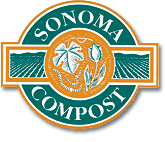 |
|
 |
||||||||||||||||||||
| COMPOST APPLICATION Compost adds valuable organic matter to soil, improving its structure and making it easier to work and more productive. Add it to sandy soil to increase moisture-holding capacity, to heavy clay soils to improve aeration and drainage. In addition, compost introduces beneficial microorganisms to soil and makes slow release nutrients available to plants. Worms, a great indicator of soil health, thrive in soils rich in composted organic matter.
Ask your salesperson about the maturity of the compost you'll be applying and whether it's appropriate for the use intended. Compost maturity is the result of a natural, biologic process that is affected by factors such as feedstock type, weather, moisture and time. The need for compost maturity can vary. Seeds, or tender young plants for your backyard garden or landscape typically require more mature compost. In applications such as new vineyard development, younger compost might be desired.
Application Rates In order to improve soil structure, many authorities recommend allowing your soil and compost to lie undisturbed together for a week or two before planting. Even better, add compost the season before planting will occur. Make sure that your plants' other needs are taken care of. These include adequate moisture, appropriate exposure to the sun, adequate nutrients and protection from frost and insect damage. And remember, planting too early or late in the season can make a profound difference to many plants. MULCH APPLICATION Mulch Application A layer of old, moistened newspapers (2-3 sheets) or cardboard placed on your soil prior to applying mulch will greatly enhance weed suppression. After application, gently water in mulches. This will "set" the mulch and keep it in place in windy conditions or on steep slopes. It will also help create a healthy interface with underlying soil or a newspaper or cardboard weed barrier. |
||||||||||||||||||||||
|
||||||||||||||||||||||
 Recommendations For
Use
Recommendations For
Use
